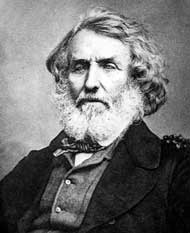<Back to Index>
- Surveyor Colonel Sir George Everest, 1790
- Novelist Nathaniel Hawthorne, 1804
- Revolutionary of the Risorgimento Giuseppe Garibaldi, 1807

Colonel Sir George Everest (4 July 1790 – 1 December 1866) was a Welsh surveyor, geographer and Surveyor-General of India from 1830 to 1843.
Sir George was largely responsible for completing the section of the Great Trigonometric Survey of India along the meridian arc from the south of India extending north to Nepal, a distance of approximately 2,400 kilometres (1,491 mi). The survey was started by William Lambton in 1806 and lasted several decades. In 1865, Mount Everest was named in his honour despite his objections. It was surveyed by his successor, Andrew Waugh. He was born in the Manor of Gwernvale at Crickhowell in Powys, in 1790. He was baptised at Greenwich. Commissioned into the Royal Artillery, in 1818, Lt Everest was appointed as assistant to Colonel William Lambton,
who had started the Great Trigonometrical Survey of the sub-continent
in 1806. On Lambton's death in 1823, he succeeded to the post of
superintendent of the survey and in 1830 was appointed Surveyor-General
of India. He
owned a house in Mussoorie, Uttarakhand, India, for some years. Although
almost derelict, it still has a roof and there are plans to make it
into a museum. Known as the Park Estate,
it is situated about 6 km from Gandhi Chowk / Library Bazaar, (West end of
the Mall Road, in Mussoorie). Built in 1832 it was the home and
laboratory of Sir George Everest. The house is situated in a
picturesque place from where one can catch the panoramic view of Doon
Valley on one side and a panoramic view of the Aglar River valley and
snow bound Himalayan ranges on the other. The
house is under the jurisdiction of the Archeological Survey of India
but it has been long neglected. The
underground water cisterns can still be seen, outside the house. The interior has been stripped but
fireplaces and the door and window frames still remain. Everest retired in 1843 and returned to live in the United Kingdom, where he became a Fellow of the Royal Society. He was knighted in 1861 and in 1862 he was elected Vice-President of the Royal Geographical Society. He died in London in 1866 and is buried in St Andrew's Church, Hove, near Brighton.